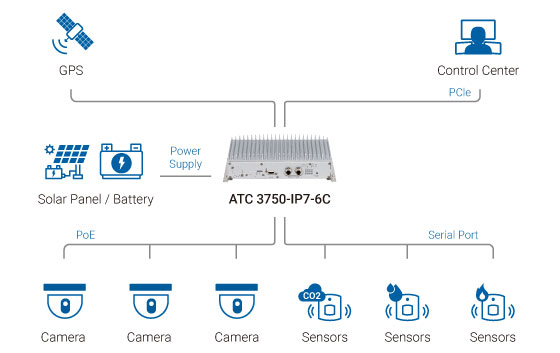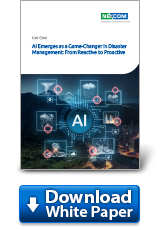AI Emerges as a Game-Changer in Disaster Management: From Reactive to Proactive

Background
Throughout history, humanity has constantly faced the threat of natural disasters, such as earthquakes, hurricanes, wildfires, and floods, which have the potential to cause extensive destruction and loss of life. However, the field of artificial intelligence (AI) is ushering in a significant revolution in disaster management, thanks to technological advancements.
AI has the power to completely transform how we predict and prepare for disasters. By utilizing machine learning algorithms and data analysis, AI can analyze vast amounts of information and identify patterns that may go unnoticed by humans. This enables us to make more data-driven, reliable predictions about when and where disasters are likely to strike, allowing us to take proactive measures to mitigate their impact.
Scenario
Limitations of Traditional Disaster Management Systems
Traditional disaster management systems rely heavily on pre-defined rules, statistical models, and human expertise, struggling with processing vast, diverse data streams and account for complex variable interactions. Besides, the traditional solutions we’ve been using up until now are falling short. While satellite images provide a broad overview, they might lack the fine detail needed for certain tasks, such as shallow landslide, assessing damage to individual buildings, due to their rapid dynamics and limited frequency of site views. Geotechnical approaches, using borehole inclinometers are expensive, complex, and time-consuming.
AI systems leverage machine learning to automatically learn from massive data sets, including real-time sensor data and camera images, enabling them to identify intricate patterns that are difficult for humans or traditional models to discern. However, disaster management systems in outdoor environments face several significant challenges. Here are some of the most critical ones:
Durability and Environmental Resilience: Outdoor equipment must be rugged enough to withstand harsh conditions, including extreme temperatures, rain, wind, dust, and even impacts from flying debris during disasters like wildfires, floods, or landslides.
Power Autonomy and Instability: Reliable power is crucial, but access to outlets can be limited outdoors. Disaster zones might even experience widespread power outages. This necessitates the system being self-sufficient with a power generator or solar panels, which have limitations on power storage and energy collection, respectively. Furthermore, the voltage fluctuations caused by unpredictable power sources, such as damaged electrical grids, temporary generators, or solar panels with variable output depending on sunlight., also can disrupt the system's operation.
Robust Connectivity and Data Transmission: Outdoor environments may experience intermittent or limited network connectivity due to factors like terrain obstructions, weather conditions, or the sheer distance from communication infrastructure. This can lead to disruptions in data transmission and potential data loss, which can negatively impact the accuracy and timeliness of disaster management efforts.
Application

System Architecture
In an outdoor disaster management system, an edge AI computing device is typically mounted on poles deployed close to the data acquisition sensors. The proposed system is based on a suitably sized photovoltaic power and charging system and a HyperLAN wireless connectivity infrastructure, also powered entirely by batteries and solar panels.
NEXCOM's ATC 3750-IP7-6C is a ruggedized edge AI computing system purpose-built for AI-powered disaster management applications, boasting exceptional processing power, seamless sensor integration, and robust connectivity.
Designed to withstand the harshest conditions, the ATC 3750-IP7-6C is built to operate in demanding outdoor environments; it is certified with IP67. With a wide operating temperature range (-20°C to 70°C), vibration and shock resistance meeting MIL-STD-810 standards, and a 9-36V DC-IN power input, this rugged edge AI computing platform can be deployed in remote locations and continue functioning reliably, even in the face of extreme conditions.
At its core, the ATC 3750-IP7-6C is powered by the NVIDIA Jetson AGX Orin, a powerhouse capable of delivering up to 200/275 (INT8) TOPS of AI processing performance. This enables the system to handle even the most computationally intensive AI models and algorithms required for disaster management tasks, running these AI workloads at the edge for real-time analysis and decision-making without relying on remote servers.
One of the key advantages of the ATC 3750-IP7-6C is its ability to seamlessly integrate with a wide range of environmental sensors. With various I/O ports, including serial and digital I/O, the system can collect data from sensors deployed in the field, providing the necessary fuel for AI models tasked with detecting early warning signs of potential disasters.
The sensors are deployed throughout the disaster zone to collect environmental data like temperature, wind speed, air quality, water levels, or ground movement. They might also include cameras for visual monitoring.
These networks connect the sensors and transmit their data either wirelessly or through cables to a central hub. Low-Power Wide-Area Networks (LPWAN) are gaining traction due to their low power consumption and long-range capabilities, which are crucial in disaster scenarios. The ATC-3750-IP7-6C offers a comprehensive suite of communication options, including Gigabit Ethernet (with PoE+ support), Wi-Fi 5/6, cellular (LTE/5G), and GNSS capabilities. This ensures seamless data transmission and situational awareness, enabling effective coordination with other agencies or response teams.






















